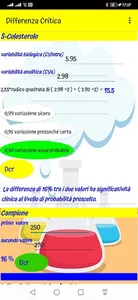When analyzing a laboratory test, in interpreting the result, it is necessary to know the reference ranges. Normal, abnormal or pathological are traditional terms, not quite correct. The term "normal" should be replaced with the term "commonly encountered in its class", which expresses the difference between the minimum and maximum values found in 95% of a particular population by age, sex etc. Then there is the possibility that significant changes may also occur within the reference values considered normal. An increase in creatinine from 54 to 100 (reference values 45 -106 mmol / L) can signal renal distress that would be overlooked by the physician if he were limited to comparing the result only with the canonical reference values. The difference between two analytical results in a patient obtained at different times is statistically significant with a probability of 95% if it exceeds the value of the “critical difference” for an analyte. The critical difference with probability of 0.05 is the most used and is defined as “the minimum difference between two successive measurements in the same patient that has a certain clinical significance”. The formula used is ((1.96 * square root of2) CVtot) = 2.77 * square root (CVa + CVintra) where 1.96 indicates the zeta offset which excludes 5% of the results for single analyzes, and 2.77 the factor to be used for the differences duplicate analyzes.
Let's see the case of a patient who was found to have a cholesterol concentration of 250 mg / dl. After a period of therapy, a second determination is 210 mg / dl. Is the therapy working? If we compare the difference between the two values (16%) with that of the critical difference in cholesterol (18.4%), we will conclude that the variation is due to random fluctuations in the results for intra-individual and analytical biological variability. Of course, this does not mean that the therapy is not working; it just means that, for the chosen probability level, you have to overcome the difference of 18.4% to have a 95% chance that there is a significant variation and 5% to be wrong in drawing the conclusion. A clean cut between results greater or less than the "critical difference" is not justified, the probabilities vary continuously. Indeed, if we are satisfied with a 90% probability variation, it is sufficient to exceed 15.5% to highlight a significant variation. However, in this case we will have a 10% chance of error.
Let's see the case of a patient who was found to have a cholesterol concentration of 250 mg / dl. After a period of therapy, a second determination is 210 mg / dl. Is the therapy working? If we compare the difference between the two values (16%) with that of the critical difference in cholesterol (18.4%), we will conclude that the variation is due to random fluctuations in the results for intra-individual and analytical biological variability. Of course, this does not mean that the therapy is not working; it just means that, for the chosen probability level, you have to overcome the difference of 18.4% to have a 95% chance that there is a significant variation and 5% to be wrong in drawing the conclusion. A clean cut between results greater or less than the "critical difference" is not justified, the probabilities vary continuously. Indeed, if we are satisfied with a 90% probability variation, it is sufficient to exceed 15.5% to highlight a significant variation. However, in this case we will have a 10% chance of error.
Show More














